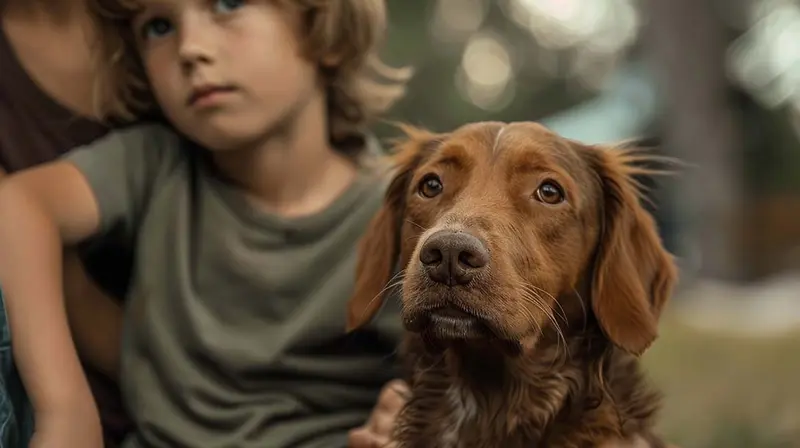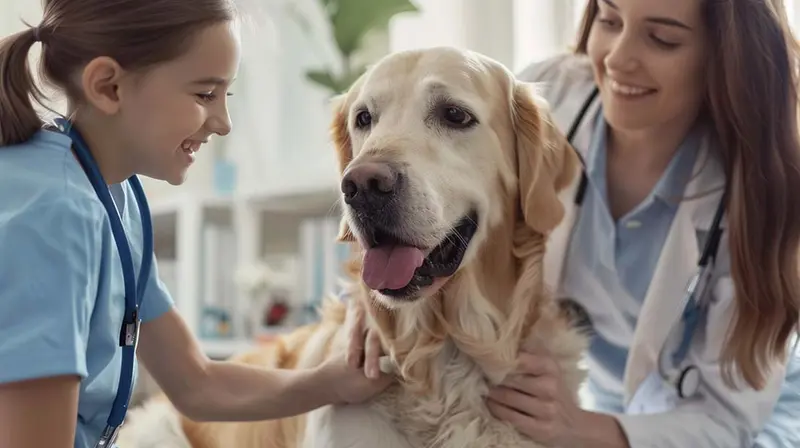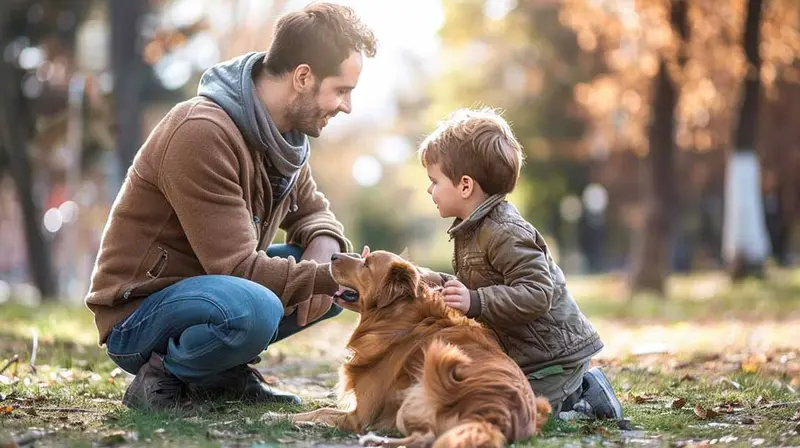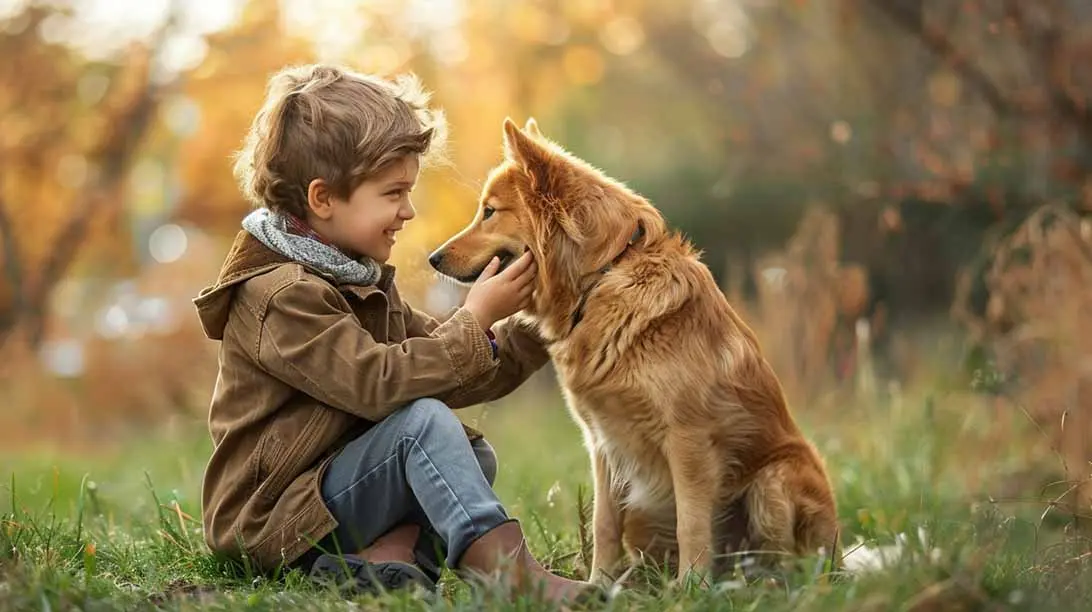Is your child afraid of dogs? You’re not alone. Many children face a fear of dogs in children that can limit their daily activities and confidence. This article offers practical tips to help your child overcome their fear and build a positive relationship with dogs. We’ll cover understanding the fear, recognizing dog body language, gradual exposure, and when to seek professional help.
Key Takeaways
- Understanding and addressing a child’s fear of dogs involves recognizing the roots of their fear and using a methodical approach to help them feel safe and in control.
- Teaching children to read dog body language can reduce their fear by making canine behavior more predictable and less intimidating.
- Gradual exposure and controlled interactions with dogs, paired with positive reinforcement and professional help if necessary, can significantly help children overcome their fear of dogs.
Introduction
Fear of dogs is a hurdle that many children face in life. It’s a fear that can present itself in various forms and intensities, from hesitance to walk past a dog in the park to an outright refusal to enter a room with a dog present. For some kids, this intense fear stems from a bad experience, like a dog jump or a painful scratch. For others, it may arise without any clear reason, manifesting as an instinctive and overpowering anxiety in the presence of these four-legged friends.
The influence of adults can’t be overlooked either. A child might mirror the apprehensive behavior of a parent or another adult when around dogs, inadvertently adopting this fear as their own. And let’s not underestimate the impact of a child’s fears. It can:
- Limit the places a child feels comfortable going
- Affect their willingness to engage in fun activities like playdates or trips to the park
- Dent their self-confidence
Keep in mind that assisting your child in overcoming their fear of dogs involves a sequence of small but significant steps. It’s not about a quick fix but supporting them through a series of experiences that gradually build their confidence. So, we should start by getting to the core of the issue: grasping your child’s fear and figuring out how to manage it collaboratively.
Understanding Your Child's Fear of Dogs

Have you ever wondered what goes through your child’s mind when they feel scared of a dog? It could be a memory of a neighbor’s dog jumping up on them, or perhaps it’s the loud bark from a dog owner’s pet that sets off their anxiety. Or maybe, they’ve picked up on your own cautiousness around dogs, adopting your fears as their own. There are instances, too, where the fear seems to have no root cause; it’s as if the fear is hardwired into their very being.
This fear of dogs isn’t just a minor inconvenience; it’s a phobia that can spill over and affect every part of a child’s life. It can limit their playtime, social interactions, and even their performance at school. It can gnaw away at their self-esteem as they struggle to understand and manage their feelings. It’s important to recognize that avoiding dogs altogether is not a viable solution. Like other phobias, evasion only reinforces the fear, making each encounter with a dog more daunting than the last.
Dealing with your child’s fear directly is crucial to help them overcome it. But how do you do this without causing more distress? The answer lies in patience, understanding, and a methodical approach that will help your child feel safe and in control. We’ll guide you on this path, starting with the critical step of recognizing what a dog is saying through its body language—a skill that can demystify canine behaviors and reduce your child’s anxiety.
Recognizing Dog Body Language

Understanding dog body language is like learning a new language that can bridge the gap between fear and familiarity. When a child learns to interpret the wag of a tail or the position of a dog’s ears, they gain insight into what the dog might be feeling. Recognizing a friendly dog’s play bow or the calming signal of a dog looking away can be incredibly reassuring.
But it’s not just about recognizing the signs of a happy dog. It’s equally crucial to identify when a dog is stressed or anxious. A dog may show signs of stress or anxiety, such as:
- yawning
- licking its lips
- raised hackles
- displaying ‘whale eye’
These behaviors indicate that the dog is uncomfortable and should be given space. If a child sees a dog exhibiting these signs, it’s a clear sign to give the dog space. These cues can help a child know when it’s safe to be around a dog and when it’s better to maintain a respectful distance.
Equipping your child with this knowledge can significantly reduce their fear. It can transform a once-intimidating creature into an animal whose actions are understandable and predictable. The next step in our guide builds on this foundation of understanding; it’s about gradually introducing your child to dogs in a way that feels safe and controlled.
We’ll examine how exposure therapy, through slowly increasing exposure and desensitization, can aid in conquering their fear.
Gradual Exposure and Desensitization

The journey to overcoming a fear of dogs isn’t a race—it’s a step-by-step adventure that requires encouragement and support. Start with something as simple as looking at pictures of dogs or watching videos together. These initial steps allow your child to become familiar with the appearance and behaviors of dogs in a comfortable, low-risk setting.
As their comfort grows, you can introduce them to the next stage:
- Interacting with a stuffed animal dog. This can be a fun way for your child to practice petting and playing without the unpredictability of a live animal.
- Observing a calm dog from a safe distance. This can be the bridge to more direct interactions.
- Moving closer to a real dog. Each progressive step should be taken at your child’s pace, celebrating their bravery as they move closer to a real dog.
Controlled play sessions with a calm, friendly dog can have a significant impact. These interactions, under close supervision, help your child build positive experiences and associate dogs with fun rather than fear. And remember, the success of gradual exposure isn’t measured by how quickly your child progresses but by the growth of their confidence around dogs, even in the same room.
Further reinforcement of this positive momentum can be achieved by instructing your child on calm and secure behaviors when around dogs.
Teaching Calm and Safe Behaviors

When it comes to dogs, how a child reacts can make all the difference. Teaching them to stand still ‘like a tree’ if approached by an aggressive dog is a valuable strategy that can prevent a situation from escalating. And if they’re knocked over, knowing to curl up ‘like a rock’ can keep them protected.
But it’s not just about reacting to dogs; it’s also about proactively teaching children how to behave around them. Encouraging gentle petting on the back and sides, speaking in calm tones, and avoiding direct eye contact are all practices that can help both the child and the dog feel at ease.
Moreover, children should learn to ask for permission before touching an unfamiliar dog, ensuring that both the dog owner and the dog are comfortable with the interaction.
As parents, your behavior is equally important. By remaining calm and non-reactive when a dog misbehaves, you’re modeling how your child should respond in similar situations. This calm assurance is vital in teaching your child that they can handle these encounters safely and confidently.
Keeping these behaviors in consideration, we can now examine how positive reinforcement can convert these safe encounters into pleasurable experiences.
Building Positive Associations

Positive experiences are the building blocks of overcoming fear. When your child has a pleasant interaction with a dog, it can change their entire perspective. A simple reward system, such as giving your child a treat when they’re around dogs, can associate these encounters with something enjoyable. This approach can be especially encouraging for children who have had a bad experience with a dog in the past.
Taking part in caring activities, such as feeding or grooming a dog, can further foster a connection between your child and the animal. These responsibilities not only build confidence but also create a sense of empathy and understanding towards dogs. Starting with small tasks ensures that these experiences are positive and manageable, setting the stage for success.
The primary aim is for each interaction with dogs to be reinforcing, slowly changing your child’s viewpoint from fear to companionship. This gradual shift in perception is essential, but if your child’s fear of dogs is severe and persistent, it may be time to seek professional help. We’ll examine the circumstances and reasons when this step might be required.
Seeking Professional Help

Watching your child struggle with a deep-seated fear of dogs can be distressing for any parent. When fear begins to encroach on your child’s everyday life, preventing them from enjoying activities or causing significant distress, it’s time to consider professional help. Therapists specializing in child psychology are adept at creating tailored plans to address specific phobias, such as the fear of dogs.
Cognitive-behavioral therapy (CBT) is a well-established treatment for anxiety disorders, including anxiety disorder related to phobias like the fear of dogs. By focusing on mental health, CBT works by changing the thought patterns and behaviors that are causing your child’s fear, helping them to manage their anxiety in a healthy way. Additionally, mindfulness exercises, such as deep breathing and visualization, can provide your child with tools to stay calm when facing their fears.
Seeking professional help is a significant step, but it’s one that can provide your child with the support and resources they need to overcome their fear. This is a process that demands time and patience, which is where our subsequent section will focus. We’ll debate the significance of patience and consistency when aiding your child in coping with their fear of dogs.
Encouraging Patience and Consistency

Patience and consistency are the cornerstones of helping a child overcome their fear of dogs. It’s crucial that children progress at their own pace, without feeling pressured to interact with a dog before they’re ready. Watching adults interact with dogs can also be a helpful step for children, providing them with a model of calm and confident behavior to emulate.
Celebrating every small milestone is important, as it encourages children to continue their journey towards overcoming their fear. Whether it’s watching someone else pet a dog or standing a little closer to a dog than before, each small success is a step in the right direction. Avoiding dogs is not the answer, as it can reinforce the fear. Instead, consistent and positive exposure to dogs, paired with the safe behaviors you’ve taught them, can make a significant difference.
The transformation from a fearful child to one who feels safe and self-confident around dogs is a testament to your child’s resilience and your steadfast support in their child’s life. As we conclude this guide, we should recap the major points and retrospect on the journey we’ve embarked on together.
Summary
Throughout this guide, we’ve explored various strategies to help your child move past their fear of dogs and embrace these animals as friends, not foes. From understanding the underlying reasons behind their fear to recognizing dog body language, we’ve laid the foundation for safe and positive interactions. We’ve discussed the power of gradual exposure, the importance of teaching calm and safe behaviors, and the role of positive associations in reshaping your child’s experiences with dogs.
If your child’s fear is particularly intense, seeking professional help can be a game-changer, providing them with the tools and support they need to overcome their anxiety. Above all, we’ve emphasized the importance of patience and consistency, reminding you that this journey is about progress, not perfection. As you and your child continue to work through their fear of dogs, remember to celebrate every step forward, no matter how small. With your loving guidance, your child can learn to navigate their fear and open the door to a world where dogs are companions, not creatures to fear.
Frequently Asked Questions
What are some signs that my child is afraid of dogs?
If your child shows signs of anxiety like crying, freezing, or trying to avoid dogs, and if their fear affects their willingness to be around dogs, it could be an indication that they are afraid of dogs.
How can I help my child feel less scared around dogs?
You can help your child feel less scared around dogs by teaching them to recognize dog body language and gradually exposing them to dogs, starting with pictures and videos, and advancing to real-life interactions at a comfortable pace. This can help your child overcome their fear.
What should my child do if approached by an aggressive dog?
If your child is approached by an aggressive dog, they should be taught to stand still and quiet, and if knocked over, to curl up. These behaviors can help prevent the dog from escalating its behavior.
When should I seek professional help for my child's fear of dogs?
It's time to seek professional help for your child's fear of dogs if it becomes severe and starts impacting their daily life. A therapist trained in child psychology can provide specific strategies and therapies to address the fear.
Can my child overcome their fear of dogs even if we don't own a dog?
Yes, your child can overcome their fear of dogs without needing to own a dog by gradually exposing them to dogs and building positive associations, such as through interactions with friends' or neighbors' dogs or in controlled therapy sessions.
References and Further Reading
To further your understanding and find additional strategies to help your child overcome their fear of dogs and safety around dogs, explore the following resources:
- Pediatric Dog Phobia Treatments - Verywell Family discusses various treatment options and tips for children who are afraid of dogs.
- Children's Book on Overcoming Fear of Dogs - A children's book that uses storytelling to help kids understand and overcome their fear of dogs.
- Animal-Assisted Therapy - GoodTherapy outlines the benefits of animal-assisted therapy for various conditions, including phobias.
- Dog Safety Education for Kids - The Red Cross offers courses on dog safety and first aid, which can be beneficial for children to understand and respect dogs.
- Reading Dog Body Language - The American Kennel Club offers a comprehensive guide to understanding canine communication cues.
- Safe Dog Approaching Protocol - Doggone Safe provides protocols for children on how to approach dogs correctly.
- The Impact of Pets on Child Development - A research article on how pets, including dogs, can influence child development and help overcome fears.
